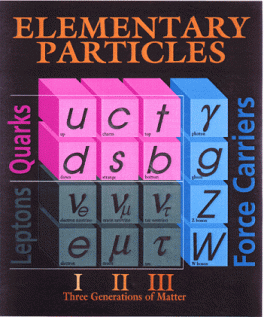High energy physics is concerned with the most elementary building blocks of nature and the fundamental forces between them. In the 20th century, physicists learned that all matter is composed of a relatively small number of elementary particles called quarks and leptons. They interact by electroweak and strong forces that are mediated by elementary particles called gauge bosons, namely the photon, the W and Z bosons, and gluons. The known quarks, leptons, and gauge bosons and the electroweak and strong forces are all described by a relativistic quantum field theory known as the Standard Model. It includes the electroweak theory, which unites the weak and electromagnetic interactions and has a symmetry that relates the massless photon and the massive W and Z bosons. The conflict between this symmetry and the very different masses is reconciled by spontaneous symmetry breaking, which requires the existence of an additional particle called the Higgs boson. The recent discovery of the Higgs boson provides the last missing particle in the Standard Model.
Relativistic quantum field theory is the basic language of high energy physics. Some aspects of quantum field theory are perturbative—that is, they can be understood in terms of Feynman diagrams. Diagrammatic methods are one of the basic research tools of the group. There are other aspects of quantum field theory that are nonperturbative. A major effort at Ohio State involves solving nonperturbative quantum field theories using lattice gauge theory, a method in which space-time is approximated by a lattice of discrete points. Another research effort uses effective field theories to develop systematic approximations to some nonperturbative aspects of a theory. Another important research direction is the study of supersymmetric quantum field theories, which have a special symmetry that relates fermions and bosons and makes some nonperturbative problems more tractable.
There are many reasons to believe that the Standard Model is incomplete, and that there are other elementary particles and fundamental forces in nature. They include the existence of dark matter, oscillations between different neutrinos, the asymmetry between matter and antimatter in the universe, and the equal strength of the three Standard Model forces at some large energy scale. A major effort at Ohio State is trying to discover the new physics beyond the Standard Model. One possibility is the unification of the three Standard Model forces into a single force, possibly through a supersymmetric quantum field theory that also unifies the elementary particles. Another possibility is that the mechanism for spontaneous symmetry breaking is more complicated than in the Standard Model and involves additional Higgs bosons.

The strong force between quarks in the Standard Model is described by Quantum Chromodynamics (QCD). This quantum field theory has perturbative aspects that can be calculated using Feynman diagrams and also nonperturbative aspects that can be calculated using lattice gauge theory and with effective field theories. A major effort at Ohio State is the study of the heavy charm and bottom quarks and their bound states using lattice gauge theory, effective field theories, and perturbative QCD. The lattice QCD calculations require the use of the most powerful supercomputers, such as are available on campus at the Ohio Supercomputer Center.
Any final theory of physics must incorporate a quantum theory of gravitation. Quantizing gravity has proved to be a difficult problem, but string theory has become established as a consistent theory of quantum gravity. String theory has a rich mathematical structure that is still being explored. A major effort at Ohio State is using string theory to explain the mysterious quantum properties of black holes. Another effort uses string theory to construct extensions of the Standard Model that go beyond quantum field theory.
Faculty
